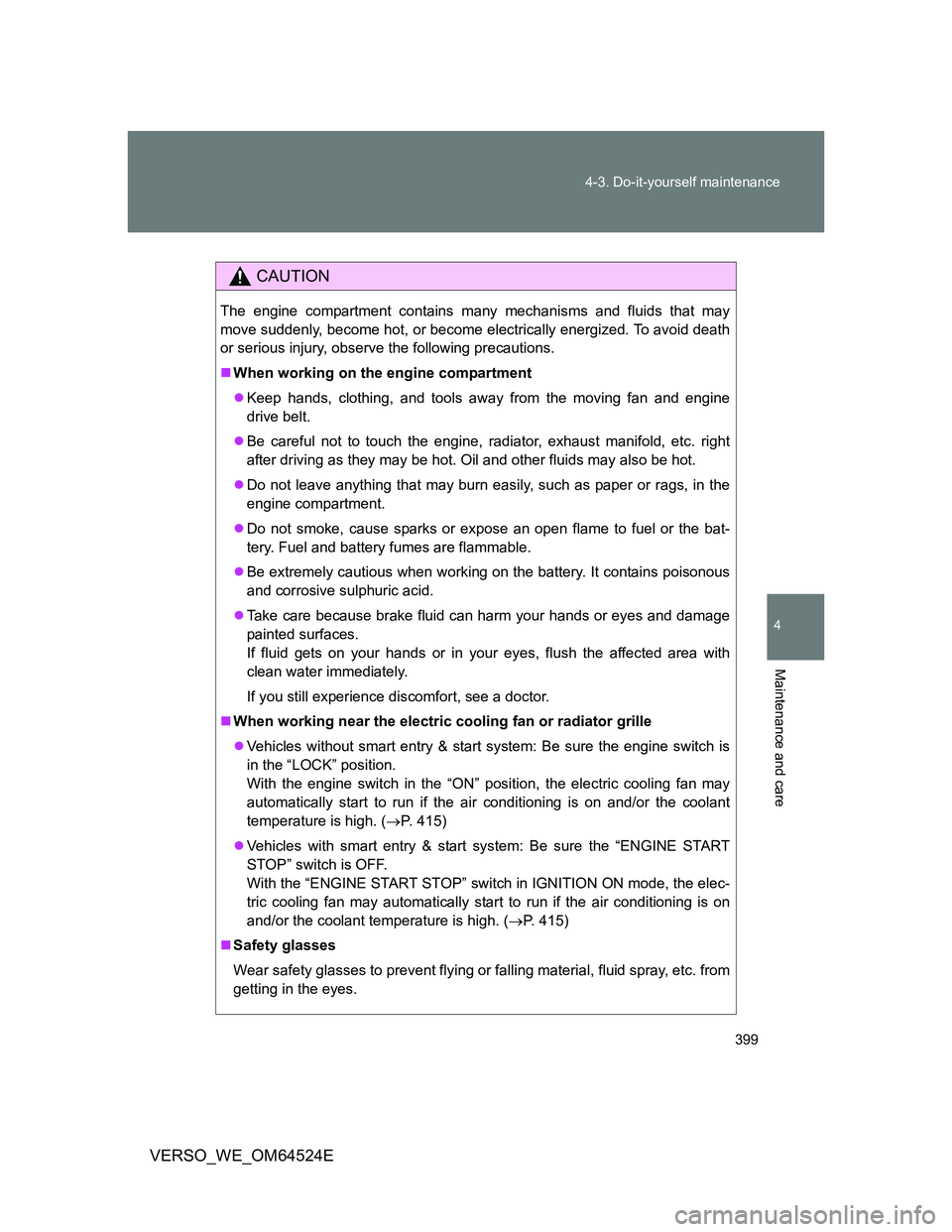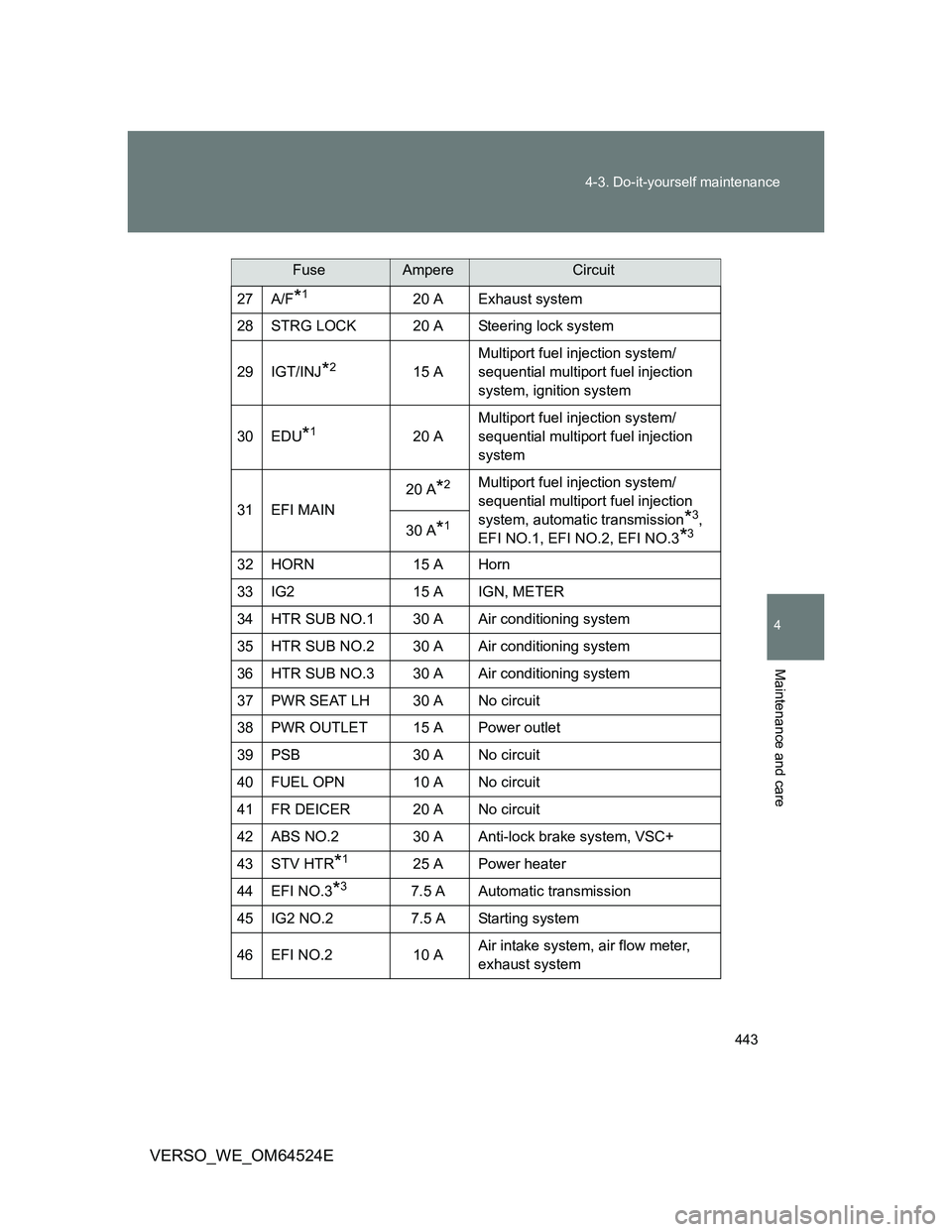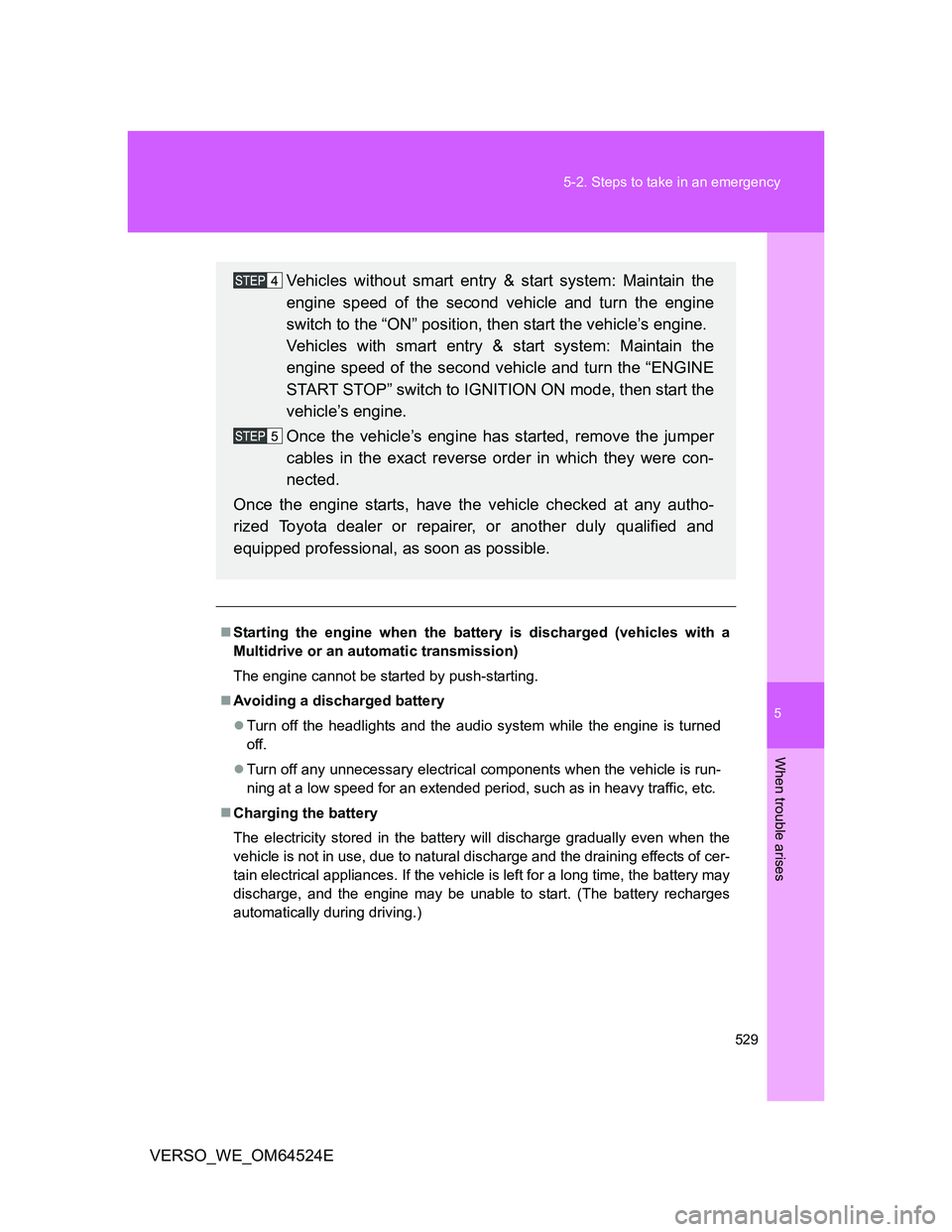Page 366 of 588
366
3-5. Other interior features
VERSO_WE_OM64524E
Power outlet
The power outlet can be used when
Vehicles without smart entry & start system
The engine switch is in the “ACC” or “ON” position.
Vehicles with smart entry & start system
The “ENGINE START STOP” switch is in ACCESSORY or IGNITION ON
mode.
The power outlet can be used for 12V accessories that run on less
than 10A.
Console box (if equipped)
Luggage compartment
Page 368 of 588
368
3-5. Other interior features
VERSO_WE_OM64524E
Seat heaters
: If equipped
The seat heaters can be used when
Vehicles without smart entry & start system
The engine switch is in the “ON” position.
Vehicles with smart entry & start system
The “ENGINE START STOP” switch is in IGNITION ON mode.
Heats the right front seat
Heats the left front seat
The indicator light comes on.
Page 373 of 588
373
3-5. Other interior features
3
Interior features
VERSO_WE_OM64524E
Panoramic roof shade
: If equipped
The panoramic roof shade can be operated when
Vehicles without smart entry & start system
The engine switch is in the “ON” position.
Vehicles with smart entry & start system
The “ENGINE START STOP” switch is in the IGNITION ON mode.
Jam protection function
If an object is detected between the panoramic roof shade and the frame
while closing, travel is stopped and the panoramic roof shade opens slightly.
If the panoramic roof shade cannot be closed automatically
Keep the switch depressed.
Use the overhead switches to open or close the panoramic roof
shade.
Open
To stop partway, press the
switch lightly.
Close
To stop partway, press the
switch lightly.
Page 399 of 588

399 4-3. Do-it-yourself maintenance
4
Maintenance and care
VERSO_WE_OM64524E
CAUTION
The engine compartment contains many mechanisms and fluids that may
move suddenly, become hot, or become electrically energized. To avoid death
or serious injury, observe the following precautions.
When working on the engine compartment
Keep hands, clothing, and tools away from the moving fan and engine
drive belt.
Be careful not to touch the engine, radiator, exhaust manifold, etc. right
after driving as they may be hot. Oil and other fluids may also be hot.
Do not leave anything that may burn easily, such as paper or rags, in the
engine compartment.
Do not smoke, cause sparks or expose an open flame to fuel or the bat-
tery. Fuel and battery fumes are flammable.
Be extremely cautious when working on the battery. It contains poisonous
and corrosive sulphuric acid.
Take care because brake fluid can harm your hands or eyes and damage
painted surfaces.
If fluid gets on your hands or in your eyes, flush the affected area with
clean water immediately.
If you still experience discomfort, see a doctor.
When working near the electric cooling fan or radiator grille
Vehicles without smart entry & start system: Be sure the engine switch is
in the “LOCK” position.
With the engine switch in the “ON” position, the electric cooling fan may
automatically start to run if the air conditioning is on and/or the coolant
temperature is high. (P. 415)
Vehicles with smart entry & start system: Be sure the “ENGINE START
STOP” switch is OFF.
With the “ENGINE START STOP” switch in IGNITION ON mode, the elec-
tric cooling fan may automatically start to run if the air conditioning is on
and/or the coolant temperature is high. (P. 415)
Safety glasses
Wear safety glasses to prevent flying or falling material, fluid spray, etc. from
getting in the eyes.
Page 411 of 588

411 4-3. Do-it-yourself maintenance
4
Maintenance and care
VERSO_WE_OM64524E
Engine oil consumption
The amount of engine oil consumed depends on the oil viscosity, the
quality of the oil and the way the vehicle is driven.
More oil is consumed under driving conditions such as high speeds and
frequent acceleration and deceleration.
A new engine consumes more oil.
When judging the amount of oil consumption, keep in mind that the oil
may have become diluted, making it difficult to judge the true level accu-
rately.
Oil consumption: Max. 1.0 L per 1000 km (1.1 qt./600 miles, 0.9 lmp.qt./
600 miles)
If you consume more than 1.0 L (1.1 qt., 0.9 lmp. qt.) every 1000 km (600
miles), contact any authorized Toyota dealer or repairer, or another duly
qualified and equipped professional.
After changing the engine oil (diesel engine only)
The oil change system should be reset. Perform the following procedures:
Vehicles without smart entry & start system
Switch the display to trip meter A (P. 220) when the engine is run-
ning.
Turn the engine switch to the “LOCK” position.
While pressing the trip meter reset button, set the engine switch to
the “ON” position (but do not start the engine because otherwise
the reset mode will be canceled). Continue to press and hold the
button until the multi-information display indicates that the reset is
complete.
Vehicles with smart entry & start system
Switch the display to trip meter A (P. 220) when the engine is run-
ning.
Turn the “ENGINE START STOP” switch OFF.
While pressing the trip meter reset button, set the “ENGINE START
STOP” switch to the IGNITION ON mode (but do not start the
engine because otherwise the reset mode will be canceled). Con-
tinue to press and hold the button until the multi-information display
indicates that the reset is complete.
Page 443 of 588

443 4-3. Do-it-yourself maintenance
4
Maintenance and care
VERSO_WE_OM64524E
27 A/F*120 A Exhaust system
28 STRG LOCK 20 A Steering lock system
29 IGT/INJ
*215 AMultiport fuel injection system/
sequential multiport fuel injection
system, ignition system
30 EDU
*120 AMultiport fuel injection system/
sequential multiport fuel injection
system
31 EFI MAIN20 A
*2Multiport fuel injection system/
sequential multiport fuel injection
system, automatic transmission
*3,
EFI NO.1, EFI NO.2, EFI NO.3
*330 A*1
32 HORN 15 A Horn
33 IG2 15 A IGN, METER
34 HTR SUB NO.1 30 A Air conditioning system
35 HTR SUB NO.2 30 A Air conditioning system
36 HTR SUB NO.3 30 A Air conditioning system
37 PWR SEAT LH 30 A No circuit
38 PWR OUTLET 15 A Power outlet
39 PSB 30 A No circuit
40 FUEL OPN 10 A No circuit
41 FR DEICER 20 A No circuit
42 ABS NO.2 30 A Anti-lock brake system, VSC+
43 STV HTR
*125 A Power heater
44 EFI NO.3
*37.5 A Automatic transmission
45 IG2 NO.2 7.5 A Starting system
46 EFI NO.2 10 AAir intake system, air flow meter,
exhaust system
FuseAmpereCircuit
Page 466 of 588
466 5-1. Essential information
VERSO_WE_OM64524E
Emergency towing
If a tow truck is not available in an emergency, your vehicle may be
temporarily towed using a cable or chain secured to the emergency
towing eyelet. This should only be attempted on hard, surfaced roads
for short distances at low speeds.
A driver must be in the vehicle to steer and operate the brakes. The
vehicle’s wheels, drive train, axles, steering and brakes must be in
good condition.
Towing eyelet
Emergency towing procedure
Vehicles without smart entry & start system
Release the parking brake.
Put the shift lever in “N”.
Put the engine switch in the “ACC” (engine off) or “ON” position
(engine running).
Vehicles with smart entry & start system
Release the parking brake.
Put the shift lever in “N”.
The “ENGINE START STOP” switch must be in ACCESSORY
mode (engine off) or IGNITION ON mode (engine running).
Page 529 of 588

5
529 5-2. Steps to take in an emergency
When trouble arises
VERSO_WE_OM64524E
Starting the engine when the battery is discharged (vehicles with a
Multidrive or an automatic transmission)
The engine cannot be started by push-starting.
Avoiding a discharged battery
Turn off the headlights and the audio system while the engine is turned
off.
Turn off any unnecessary electrical components when the vehicle is run-
ning at a low speed for an extended period, such as in heavy traffic, etc.
Charging the battery
The electricity stored in the battery will discharge gradually even when the
vehicle is not in use, due to natural discharge and the draining effects of cer-
tain electrical appliances. If the vehicle is left for a long time, the battery may
discharge, and the engine may be unable to start. (The battery recharges
automatically during driving.)
Vehicles without smart entry & start system: Maintain the
engine speed of the second vehicle and turn the engine
switch to the “ON” position, then start the vehicle’s engine.
Vehicles with smart entry & start system: Maintain the
engine speed of the second vehicle and turn the “ENGINE
START STOP” switch to IGNITION ON mode, then start the
vehicle’s engine.
Once the vehicle’s engine has started, remove the jumper
cables in the exact reverse order in which they were con-
nected.
Once the engine starts, have the vehicle checked at any autho-
rized Toyota dealer or repairer, or another duly qualified and
equipped professional, as soon as possible.